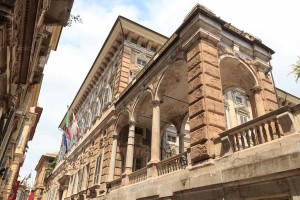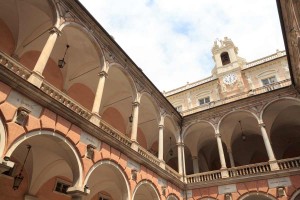
©Bigstock.com/johannes86
The Republic of Genoa hit its absolute peak in the 16th and 17th century. Major patrician families furthered trade relations achieving unprecedented wealth to the benefit of the entire region. In order to advertise this affluence, nobility and patricians established Le Strade Nuove (“New Streets”) which had a system of magnificent noble palaces and abundant patrician houses, the so-called Palazzi dei Rolli, built around them. These architectural masterpieces in Renaissance and baroque style continue to fascinate to this very day and were deservedly elevated to UNESCO World Heritage status in 2006.
A revolutionary road project
Around mid-16th century the Republic of Genoa experienced a genuine boom. In order to give their world-spanning power a representative face, the construction of buildings for state visit receptions was furthered. Le Strade Nuove was to become the city’s wealthiest district and place of residence for the most important families. Architectural elements from the Renaissance and baroque period were chosen for the individual palaces. They gave -and give – the Strade Nuove a consistent yet highly diverse look of fully individual buildings that appear architecturally connected to one another despite obvious stylistic differences and variations. As weird and contradictory as it sounds, it actually works very well.
But why are the palaces of this revolutionary road project – the UNESCO calls it the successful commencement of modern, urban architecture in Europe – actually called Palazzi dei Rolli? “Rolli” were official lists of structures for holding receptions for the above-mentioned state visits. First compiled in 1576, the palazzi were grouped into different “Bussoli”, which can be compared to today’s star ratings in the hotel sector. The more magnificent a palace, the higher its Bussoli rating.
3 streets, 42 palaces, one World Heritage Site

©Bigstock.com/johannes86
Today’s World Heritage Site doesn’t include all palaces of Le Strade Nuove, consisting of Via Giuseppe Garibaldi, Via Balbi and Via Cairoli, by a long shot. Effectively, “only” 42 of the 163 Palazzi dei Rolli, mostly dating back to the late 16th and early 17th century, made it onto the list. They stand for extraordinary diversity in architectural realization of a joint idea. Many are now used as museums and public buildings while others remain private residences.
Listing and describing all 42 palaces would be a bit much. After all, you’re only interested in the absolute highlights of these splendid roads, right? We’ve compiled some of our favourites and must-sees for you.
The Strada Nuova Museums
Several glorious palaces await you while walking along Via Garibaldi, three of which are home to stunning art galleries. The so-called Strada Nuova Museums invite you on a journey back in time diving into the fascinating history of the Republic of Genoa displaying artistic highlights of the Genoese school of painting as well as the most famous European painters from the 12th to the 18th century. Don’t miss out on these almost magical places!
Palazzo Rosso
Here’s an odd one: This palace built in 1675 was not one of the original 163 Palazzi dei Rolli, but it still became a World Heritage Site. You’ll understand this decision immediately when looking at the imposing red façade with a marble perron. One of Genoa’s most important art galleries is hidden behind it. Works by Giovanni Francesco Barbieri, Albrecht Dürer, Guido Reni, Anthonis van Dyck and Paolo Caliari line the ostentatious halls. Some of the original mosaic floors and wall frescoes were unfortunately destroyed during an air raid in World War II, but that doesn’t affect the glory and splendour of this palace one bit.
Palazzo Bianco
Originally named Palazzo Luca Grimaldi after its constructor, this palace, which was bequeathed to the city in 1899, now acts as a well-deserved home to some of the most significant Genoese painters of the 17th and 18th century, such as Giovanni Benedetto Castiglione, Alessandro Magnasco and Bernardo Strozzi. Other milestones of the European painting world from the 12th to 17th century were collected from several private collections to be displayed here. See famous works by Rubens and van Dyck, Caravaggio, Paolo Veronese, Hans Memling, Filippino Lippi and many more.
Palazzo Doria Tursi
The most imposing palace in Via Garibaldi was built on three lots of land in 1565 and expanded by another two loggias in 1597. The uniqueness of this building even lead to erroneous attributions to Michelangelo, for example by famous French author Alexandre Dumas (“The Three Musketeers”, “The Count of Monte Cristo”). Mayoral assembly halls aside, you’ll find a continuation of the Palazzo Bianco art gallery inside this palace with objects of arts like Paganini’s legendary violin plus coins, weights and measures dating back to the Republic of Genoa.
Other palaces worth seeing
Another 39 UNESCO Rolli palaces along three roads await you beyond the three museum palazzi in Via Garibaldi. Where to start, where to go? Your ZAINOO experts have a few suggestions at hand:
- Palazzo Reale: 400 years of eventful history are hidden behind the walls of Palazzo Stefano Balbi, as this stunning building is also known. Originally constructed for the Balbi family in 1618, it was sold to the Royal House of Savoy in 1823 before falling into the ownership of the Italian Republic in 1919. A museum with 23 exhibition rooms is hidden behind the glowing façade. There’s a lot for you to see ranging from the monumental atrium with dapper 18th century stucco ornamentation to the hanging garden to the throne hall and the noble apartment.
- Palazzo Doria-Spinola: Today’s seat of the prefecture and the Province of Genoa can be traced back to Antonio Doria, cousin of the legendary admiral Andrea Doria. Rather inconspicuous from the outside, an unhurried tour of the palace reveals fascinating treasures. The decorations with scenes of the Trojan War and battles between sea monsters will amaze you.
- Palazzo Durazzo-Pallavicini: Hanging garden, colonnade and breath-taking stairwell – three good reasons to visit this palace. Palazzo Durazzo-Pallavicini leads you directly to the astonishing art gallery of Palazzo Bianco.
- Palazzo Angelo Giovanni Spinola: Named after its constructor, the ambassador of the Republic of Genoa to Spain, this palace has been in the ownership of various banking houses since 1919. Frescoes of the Calvi brothers grace the façade depicting members of the Spinola family in traditional Roman Condottiere costumes. The stairwell lined with grotesque frescoes lead you to the upper floor, richly decorated with frescoes as well. Andrea Semino, Bernardo Castello and Lazzaro Tavarone, who likely contributed to the façade frescoes as well, are among the artists who immortalised themselves here.
We’ve only managed to scratch the surface with seven of 42 Palazzi dei Rolli along Le Strade Nuove. It goes without saying that there’s an abundance for you to discover and experience, and don’t even get us started on the palaces that weren’t included on the UNESCO list. Time to kickstart your Genoa holiday planning!